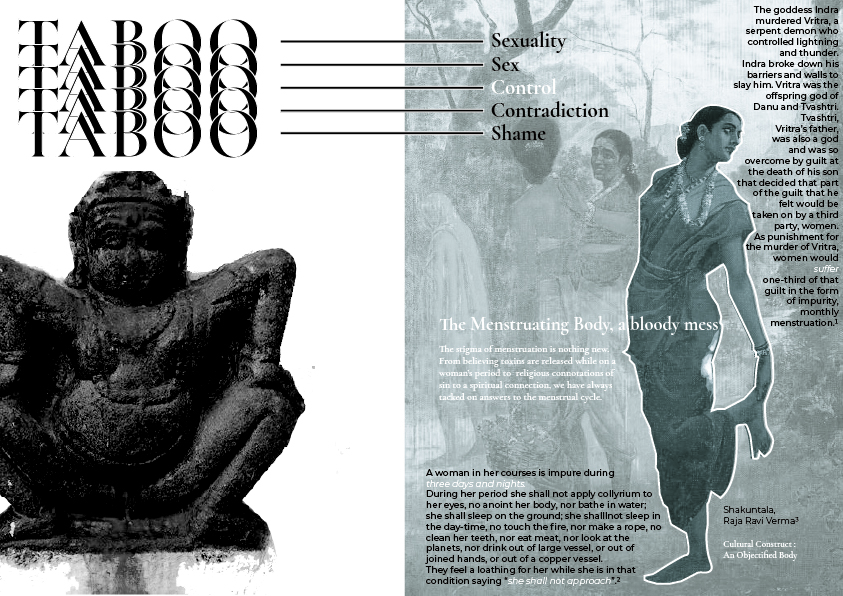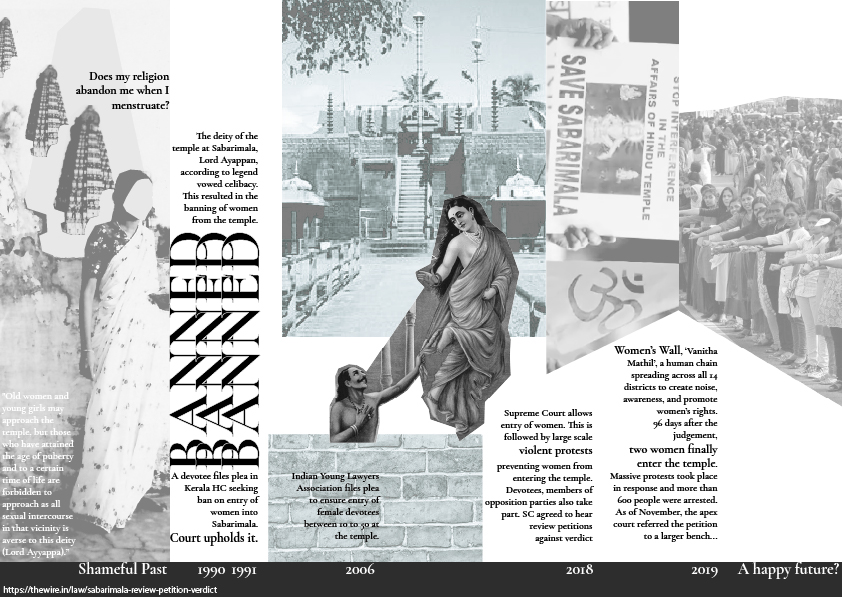Shrine of the Menstruator
Deconstructing ‘Leaky Bodies’
Shrine for the Menstruator was developed initially as a zine to relay a timeline and core stakeholders of a protest that began in 2006. It was initially developed within the framework of architecture and protest and looks at multiple methods to creating visibility and re-writing the narrative around menstruation.

Zine Page: Contextual Framing
Context:
In 1991, a petition was filed by a devotee to restrict the entry of women between the ages of 10 and 50 into the Sabarimala Temple located in Kerala.
Menstruation is a subject that is considered taboo across the world and is seen as such especially in religious contexts. In India, Hindu women are not allowed to enter temples during their cycle. Through history, we see the that the female body has constantly been put to certain standards and values.

Zine Page: Image of the Indian Woman
There is a contradiction in how it is represented in culture. On one hand you have the ideal Indian woman who is the housewife and on the other hand you have a highly sexualized body.

Zine Page: Timeline
The context of my project is in Kerala where a temple has had recent fame due to a legal grant of access into the temple by menstruaters. This is where previously women between 10 to 50 were denied entry due to the fact that the deity was celibate.
In 2018, a 1990 petition was overthrown to allow women entry into this temple. This was met by backlash from devotees that disagreed, political parties, and the women devotees.

Zine Page: Land Ownership
The temple land however, is government owned due to earlier discrimination. This brings to light the question: If temples are public spaces? Who decides what a person can do on this land?
The temple is regulated by an administration established by the devotees and the government.
The temple is regulated by an administration established by the devotees and the government.
As per the constitution, a temple has religious freedom to establish certain regulations over the activities of the land. The constitution (Article 26) gives freedom given to the temple authority towards acts done in the pursuit of religion. However, the Supreme Court has established that it only applies to 'rituals and observances, ceremonies and modes of worship which are integral [or essential] parts of religion.'


Zine Page: Intervention/Roadside Shrine and Feminist Theology


Zine Page: Planting Toilets
I propose three interventions to bring change at varying scales. The introduction of toilets along the path to the temple, complete with sanitary napkin dispensers, will bring visibility and infrastructure to the temple.
Secondly, using the wayside shrine will make the deity accessible and allow for worship as a sign of protest, and finally, to use feminist theology as a means of changing how we read religious texts.

Zine Page: Planting Toilets - Axonometric
The shrine for the menstruator is a wayside shrine, used to break down the stigmatized menstruating body by providing accessibility. While the act of using a wayside shrine is in itself a form of protest, the project intends on utilizing the normalcy of a typical shrine while housing within it the processes of menstruation. There are a number of constructs that exist in the media today that are directed towards the external image of menstruation.
The shrine instead dedicates itself to directing the gaze inward and moving towards a body of medical knowledge around the uterus. Using images of hysteroscopy and hysterography, a more abstract movement of blood within the uterus is generated to introduce curiosity rather than fear from lack of understanding.
The use of AR helps to avoid demolition and acts of violence against the concept of menstruation and religion.
The use of AR helps to avoid demolition and acts of violence against the concept of menstruation and religion.


AR Model: Development of Wayside Shrine